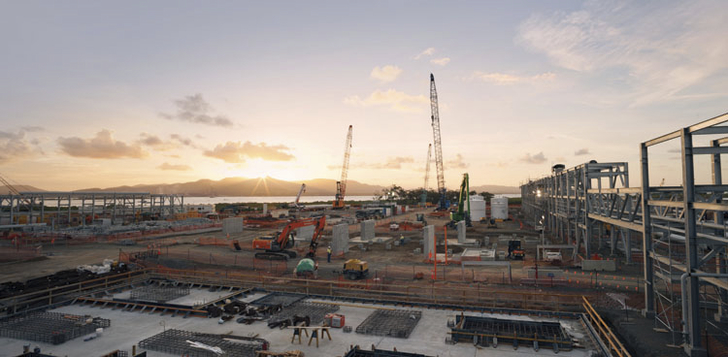Many sectors of the global construction market have been somewhat quiet in recent years but Australia is a notable exception. There is little doubt as to the intensity of the major project work that has been taking place across the far reaching areas of mineral rich regional Australia during that same period.
Major mining projects have continued to provide a great deal of work for local, national and international crane and construction contractors. Cranes are there from almost every manufacturer and even from several global crane houses. From Al Jaber to Sarens and from Mammoet to McNally’s, there has been a wide selection of international cranes competing for work with local companies located on various job sites, some of which are 10,000 miles (16,000 km) or more away from their home bases.
These major projects are taking place across many different challenging environments. Extremely high temperatures are prevalent in summer months. In many cases there is complete isolation, with entire villages of portable accommodation and workshop facilities springing up overnight, some of which are located hundreds, or even thousands of kilometres away from major population centres. One of the global contractors that have successfully embraced these challenges over a long period of time is Bechtel.
Australian OHS Regulations require that registered mobile and tower cranes complete a major inspection at the end of their design life, as recommended by the manufacturer of the crane. In the absence of accurate lift records and prior to the introduction of data loggers, the Australian crane industry has grown to accept a period of 10 years from the crane’s commissioning as the end of design life as found in Australian Standard AS 2550.1 and Codes of Practice. The completion of a major inspection is often the single most expensive maintenance and service event in the crane’s life. The combination costs of downtime plus overhaul expenses have created large variability in the content and thoroughness of major inspections completed nationally.
This major inspection requires an assessment of both the mechanical and structural components by competent persons under the supervision of a professional engineer according to manufacturer’s recommendations. In an effort to standardise the major inspection scope and processes, The Crane Industry Council of Australia (CICA), has developed a voluntary verification programme called The Gold Plate to audit completed major inspections. The criteria for the major inspection verification are based on well-established codes of practice and Australian standards.
Crane people
Machinery requirements are not the only challenges for Nisson. Finding personnel who have the full range of skills required for a project with such a wide range of cranes is another demand. Nisson fondly remembers days gone by when each of the larger cranes was assigned an oiler to assist with crane operations and received hands-on training by the crane operator, often during breaks in work activity. Today the load moment indicators (LMI) in cranes have lifted the levels of safety tremendously, but the crane operators have perhaps lost some of the load assessing skills and machine-specific familiarity they once had. Bechtel invests a great deal of energy to find people who still maintain a wide range of those skill-sets, yet have adapted into today’s safety conscious operators and riggers to keep safety at the top of its activity agenda.
It is not just large crawler cranes keeping the materials moving on the massive Curtis Island projects. Each one of the eight large desalination tanks have Liebherr tower cranes supplied to Bechtel by Morrow Equipment. These cranes range from the 420 EC H-16 up to 550 HC 40s. The saving in ground space required by erected tower cranes and the modularisation of components were key considerations in choice of crane style.
With at least another three years before full project completion, and possible extensions to the planned size still to come, BES will continue to maintain its own high levels of maintenance across the entire fleet of equipment. Planned replacements of smaller cranes, for example, the popular locally produced Terex Franna pick and carry cranes, will be managed based on asset value and capitalisation costs at the time. Kiu noted that conducting further Gold Plate verified major inspections would certainly be an option for a wide range of their cranes, especially if the outlook for project work and crane rental opportunities in Australia continues to provide continuity. With more than AUD$ 350 million (US$ 325 million) of equipment to manage onsite at any time, Kiu, Nisson, and their teams certainly look to continue to be busy for a good while yet.
Author; Laura Hatton
Source:


